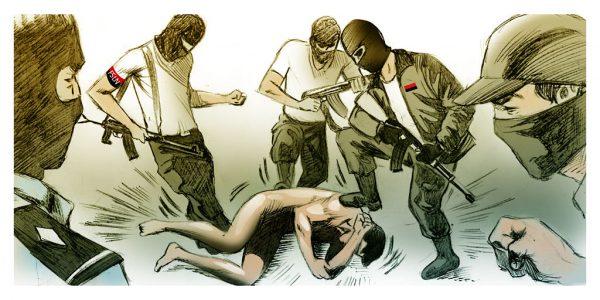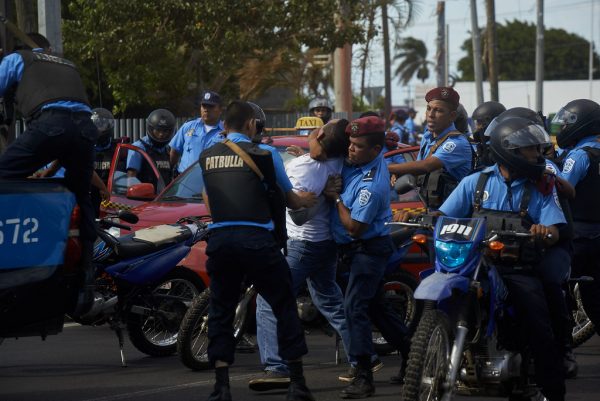Tribunal Hears Ortega Regime’s Crimes of Sexual Violence

Eleven women and seven men testified in Costa Rica, bearing witness to the regime’s crimes against humanity.
By Cindy Regidor (Confidencial)
HAVANA TIMES – On Tuesday, September 8, the Tribunal of Conscience on Sexual Violence and Crimes against Humanity in Nicaragua opened in Costa Rica. The crimes committed happened during the repression unleashed by the Ortega Murillo regime. There goal was to quash the massive citizen protests that began in April 2018. The Tribunal offers the victims of these crimes the opportunity for denunciation and symbolic justice.
Victims turn to the Tribunal of Conscience due to the lack of solid institutions and justice in Nicaragua. They can’t recur to the established Nicaraguan judicial structures, since these remain controlled by officials accused of perpetrating the crimes.
“It’s a symbolic act for the victims whose human rights were violated. It also seeks to empower them to demand their rights. It grants them symbolic, individual and collective recognition which also helps them heal.” This was the explanation of Rodrigo Jimenez, who served as moderator for the process. The initiative also seeks to systemize and document the testimonies. In this way, it raises awareness in the international community of these horrible acts, and strengthens the demand for justice.
Testimonies of sexual violence
Eleven women and seven men from different Nicaraguan cities presented their testimonies. The events they reported occurred between April 21 and August 18, 2018. All took place within the context of the citizen protests that the government repressed via the police and paramilitary groups.
Some of the victims previously had ties to the government and the Sandinista Front. Others had experience in social activism. The majority, though, took part in a protest demonstration for the first time.
The victims testifying were detained at home or along the highways by hooded civilians and public security forces. They were later taken to police stations or to the Directorate of Judicial Aid, better known as the El Chipote jail. This site is often cited as a place where demonstrators and political prisoners faced torture.
The testimonies spoke of physical tortures such as blows, kicks, broken teeth, and nose and jaw fractures. They also spoke of psychological torture. Authorities forced them to watch others being tortured, flung urine or excrement at them, cut off their food and water. Beyond that, they threatened to kill them or to kidnap and kill their loved ones.
Sexual violence included all forms of rapes, in some cases with objects. There were also cases of multiple rape and burning genitals with acid. Some women miscarried during their arbitrary capture.
For security reasons, the victims offering their testimony weren’t present at the session, held in a hotel conference room. Instead, they met outside the Costa Rican capital and followed the proceedings online.
The makeup of the Tribunal
The Tribunal is made up by five female judges. They have vast experience in the Inter-American Human Rights system and in the UN. There are also human rights advocates with ample careers in the field. Almudena Bernabeu, an example of the latter, is an outstanding attorney in the field of penal justice. She is the lead prosecutor on the case of the Jesuits massacred in El Salvador, currently underway in Spain. Her previous work led to the conviction of Guatemalan dictator Efrain Rios Montt, found guilty of genocide.
The tribunal includes Dr. Sonia Picado, president of the Inter-American Institute for Human Rights. Dr. Picado was formerly a judge in the Inter-American Court of Human Rights. She is currently a member of the UN Managerial Council on Human Security.
Clemencia Correa, also on the Tribunal, is a psychologist and human rights advocate specialized in the treatment of torture victims. She served as expert witness for the Inter-American Court of Human Rights. Then there’s Dr. Alda Facio, founder of the Women’s Caucus for Gender Justice in the International Criminal Court. She also founded the program Women, Justice and Gender, under the UN’s Latin American Institute for Crime Prevention. She’s an expert on the UN Human Rights Council, which safeguards against discrimination of women, in law and practice.
Finally, the Tribunal includes Bianca Jagger, a native Nicaraguan and human rights advocate. Jagger previously collaborated with Amnesty International and Human Rights Watch. She’s currently a Good Will Ambassador for the European Council and participates as a special guest.
The judges will use legal logic. That means using the principles of human rights and legal order to evaluate the testimonies, acts, and evidence. The trial will be based on the International Code of Human Rights, International Criminal Law, and Nicaraguan Criminal Law.
The precedent of Vietnam
The Arias Foundation for Peace and Human Progress organized the exercise. It’s based on the tribunals created by British philosopher Bertrand Russell. In 1966, Russell organized similar tribunals to make visible the war crimes in Vietnam and “prevent the crime of silence”. These tribunals found the United States guilty of genocide against the Vietnamese people.
From then on, the initiative has been replicated in many places to expose crimes against humanity. It involves the establishment of a tribunal of international opinion, made up of well-known personalities. The “Russell Tribunals” have ruled on human rights violations in Latin America, the Middle East, Eastern Ukraine and Iraq.
In December 2018, the Interdisciplinary Group of Independent Experts (GIEI) of the Inter-American Human Rights Commission issued their report. This document stated that the Nicaraguan state had committed acts that should be considered “crimes against humanity.” GIEI reached its conclusions after studying the events that occurred in the country between April 18 and May 30, 2018. The GIEI further noted that these crimes have no statutory limits and are not subject to amnesty.
The Tribunal in San Jose examines three kinds of evidence: documentary, testimonial and expert.
During the first session held on Tuesday, September 8, the Tribunal presented four expert witnesses. These presented evidence on psychosocial aspects, context, legal issues and on the chain of command.

Experts testify
The first expert testimony presented on Tuesday morning involved the legal issues. Soraya Long, an international consultant specialized in human rights, took the stand. She explained how criminal acts are typified in Nicaraguan legislation and in international and human rights penal norms. She spoke of the classification of sexual violence, torture, and crimes against humanity.
Eighteen people testified before the Tribunal as victims of sexual violence. They spoke of threats of rape, having their private parts touched, their breasts pinched or bitten, and the introduction of objects. Of those offering testimony, ten women and two men suffered rape, in some cases multiple, simultaneous rapes by several perpetrators. There was greater viciousness against the woman, the expert declared.
“The act of violence in itself was a form of repression or punishment for participating in the demonstrations or roadblocks.” Soraya Long added that in the case of people formerly tied to the government, the level of cruelty was greater. These were repeatedly badgered as to why they had helped the protesters.
Dr. Long first described the different sexual aggressions. She then established that the authorities used sexual violence and rape as a tactic for repressing the demonstrations.
“The practice of sexual violence in Nicaragua on the part of state agents constituted torture,” Dr. Long concluded. Rape classifies as torture when there’s intentionality. The law also considers severity, suffering and the end goal of the act. In the testimonies reviewed, those three elements were evident, stated the expert.
Clearly crimes against humanity
Dr. Long added that the required elements exist to classify the torture practiced in Nicaragua as a crime against humanity. It was clearly perpetrated by state agents as a predetermined strategy. That is, it was done with intentionality and knowledge of the plan. The agents also practiced it in a generalized and systematic way against a civilian population to accomplish an objective.
“Sexual torture, especially rape, formed part of a systematic plan of the Nicaraguan authorities. It was accompanied by promoting impunity in areas of human rights and crimes against humanity,” she detailed.
Dr. Long is also the former director of the Center for Justice and International Law (CEJIL) in Costa Rica. She emphasized that under both Nicaraguan and international norms, there is no tolerance for torture under any conditions.
Dr. Long assured that there’s an agreement in the international community regarding crimes against humanity. These are named even when a particular state hasn’t ratified the conventions or treaties where this crime took place. “In the case of Nicaragua, they haven’t ratified the Rome Statute of the International Criminal Court. However, their own legislation establishes torture as a crime against humanity,” Long stated.

Background leading up to the crimes
The expert witness regarding Context was Dr. Xavier Melendez, a sociologist specializing in topics of security. He reviewed the background to the events, including Daniel Ortega’s return to power in 2007. Other leadup events included dismantling the democratic institutions and rule of law, and the stigmatization and criminalization of civil society. Further, he spoke of the reverses in the process of professionalizing the Nicaraguan army and police forces. Finally, the context included the de facto elimination of the protestors’ right to demonstrate and mobilize.
Melendez also went over the details of the civic insurrection that began in April 2018 and the government’s repressive response. He spoke of how the government utilized the FSLN structures to sustain repression and human rights abuses. He spoke particularly of the creation of an armed paramilitary structure. Finally, he elaborated on why state agents commit acts of sexual violence in the context of their exercise of power.
The researcher and psychologist who gave specialist testimony on pscho-social matters remained anonymous for security reasons. This expert took up the impact of these acts on the social psychology of the Nicaraguan people. In addition, this testimony elaborated on the psycho-social harm that victims of sexual violence and torture suffer.
The victims exhibited symptoms of post-traumatic stress disorder, which implies significant emotional suffering. “For the victims, the sexual torture hasn’t been relegated to the past, but remains inscribed in their bodies. Symptoms of it continue to appear, affecting all areas of their life,” the witness affirmed.
Who gave the orders?
Finally, retired Nicaraguan Army Major Roberto Samcam gave expert testimony regarding the chain of command. He offered details of how to establish who gave the orders.
The testimonies, he stated, allow us to know which official or clandestine jails were the sites of the abuses. It also allows us to recognize the characteristics of the captors and forms of torture and to identify patterns of behavior.
President Daniel Ortega and Vice President Rosario Murillo represent the highest point on the chain of command. Responsibility then extends downward in a subordinate chain of command. This is made up of police chiefs, FSLN political secretaries, mayors, legislators from the governing party and other government functionaries.
“We define presumed individual responsibilities according to the level of police command. In the first place, there’s the top of the chain of command, where the orders came from. One of the elements responsible was the fatal order given by Rosario Murillo: “We’re going in with everything.” The others at the top are Daniel Ortega and National Police Chief Francisco Diaz. The latter distributed said orders to the next link in the chain of command,” Samcam explained. He then went on to read the names of the rest of the police authorities. He noted that the Ortega-Murillo regime then promoted some of these figures as a “reward”. Samcam also presented the chain of individual party responsibilities and those of the municipal governments.
In upcoming days, the tribunal will deliberate, after which they’ll make known their sentence. The latter is expected on Friday, September 11.





